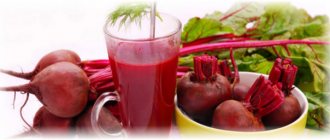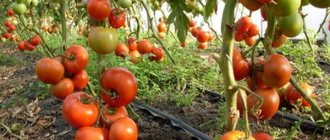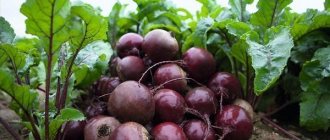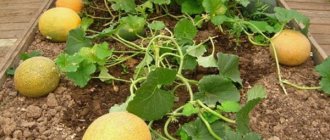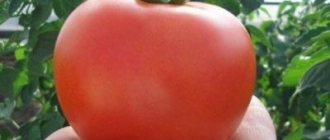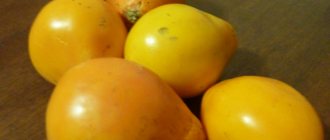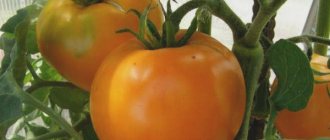Photo of the plant
Here you can see a photo of beets:
Features and description of beet variety Bordeaux 237
The first in the series is the Bordeaux 237 variety, obtained in 1937. Approved for cultivation in all regions of the country. Beets are similar in appearance and taste. Rosettes of leaves are semi-erect. Moreover, the petioles are not purely green - their underside is red. The leaves are oval, typical green in color, the surface is medium bubbly, with slight waviness at the edges.
Bordeaux beet roots 237 are medium and large, round in shape. The average weight is from 230 to 510 g. The pulp is dark red, the taste is good and rich. The composition includes water (81%) and dry matter (19%), including sugar (total content up to 14%).
The yield of the Bordeaux 237 beet variety averages from 360 to 453 c/ha, which corresponds to 4–8 kg per 1 m2. The maximum figure of 797 c/ha was registered in the Kursk region. Commercial products have a yield of 94% to 98%, so the variety is grown both in personal and on farms.
Growing instructions
Buying seeds
There are two types of seeds on sale: “Bordeaux 237” and “Bordeaux single-seeded beetroot”. The second variety has a lighter root weight (150-230 grams). Seeds can be purchased all year round in specialized stores for gardeners and in chain stores during the planting period.
Depending on the manufacturer, the price ranges from 12 to 50 rubles per sachet. Pack weight 3-5 grams, contents 40–50 pieces. Often there is garbage inside.
When to plant?
You can start planting beets at the end of April or in the winter method in the second half of October, before the first frost, so that the seeds do not die. Before winter, it is good to add humus to the soil, and in spring mineral fertilizer.
Selecting a location
Bordeaux is planted only in sunny areas; even slight shading can significantly reduce the yield. The root crop grows well in places where potatoes, cucumbers, tomatoes, and onions previously grew.
The soil
It is important to pay attention to soil acidity indicators. This variety requires neutral or slightly acidic soils for good growth. Even with a slight increase in acidity, the root vegetables become very small and become fibrous and tough. When there is an excess of alkali in the soil, fungal rot appears on the roots and leaves. Neutral loamy soil is the best option for growing beets.
Landing
Bordeaux is planted in a row method, the width between the rows is 45 cm. And they also use two-line sowing, in which the distance between the rows remains the same as in the first case, and 20 cm are left between the ribbons. The three-line sowing method can be done in the same way. On heavy soils, the seeds are deepened by 2 cm, on light soils by 4 cm. The bed is formed of high or medium height.
Temperature
Bordeaux belongs to cold-resistant crops. Its seeds begin to germinate at a temperature of 4-5°C. Growing temperature +22°C. Does not tolerate frost well. The seedlings can withstand temperatures down to -2°C. Prolonged cold snap leads to a halt in the growth of root crops.
Watering
The first watering of beet beds is carried out immediately after sowing. This allows you to get quick shoots. Increased watering will also be required during the period of fruit formation. Next, you should follow a moderate regime. In hot weather, the beds should be watered daily or every other day.
The soil should not be allowed to dry out, as this will lead to the death of germinating seeds. Adult plants are watered once a week. In hot weather, you should not water during the day, as beets have delicate leaves that can get burned. It is better to do this either at sunrise or sunset. Overwatering the soil can lead to cracking of beet roots.
Other measures
Immediately after the sprouts emerge, you need to thin out, form a row and control the distance between plants. This measure allows you to regulate the size of the root crop.- Carry out timely weeding and loosening between rows. Weeding should be done after each watering and rain.
- Feed the plant. Bordeaux quite actively consumes nutrients from the soil during the entire ripening period, so fertilization is extremely necessary.
- Under no circumstances should beets be hilled.
Description of the Bordeaux beet variety
The culture produces a semi-erect rosette with green petioles. The leaves are oval, with or without wavy edges, green, the surface is slightly bubbly. Petioles are green. Bordeaux beets are single-seeded, i.e. It produces only one sprout, making it easy to grow.
The roots are round, with very weak suberization of the head or without it, the flesh is red. The mass reaches 200–350 g. The taste is characterized as excellent. Can be used fresh for preparing various dishes. During heat treatment, the pulp does not lose color.
The composition includes water (81%), dry matter (19%), sugar (12–13%).
Prevention
To avoid problems, before planting, it is recommended to soak the seeds in a solution of potassium permanganate. This will disinfect and disinfect the seedlings. Immediately after planting, sprinkle the beds well with ash, this will reduce the acidity of the soil and repel midges. Particular attention should be paid to removing weeds. A “littered” bed not only destroys the plant and inhibits its growth, but is also a breeding ground for insects.
Bordeaux 237, without exaggeration, is a classic of domestic gardening. The variety will please both beginners and experienced gardeners. With a minimum of care, a good harvest is guaranteed. Many gardeners, having tried other varieties, still return to the time-tested Bordeaux 237.
Interested in learning about other beet varieties? Read articles from our experts about the fruitful variety Detroit, the unpretentious hybrid Vodan F1, the Dutch Boro F1, the popular Kestel F1, the healthy Pablo F1 and the root vegetable with a sweet taste - Mulatto.
Origin story
Bordeaux beets were bred at VIR named after. N.I. Vavilova. The variety was obtained by a team of breeders (Burenin V.I., Pivovarov V.F., Piskunova T.M. and others). Bordeaux 237, developed in 1937 and entered into the register in 1943, was taken as the basis.
The Bordeaux variety has been successfully tested. It was included in the register of breeding achievements of the Russian Federation in 2003. Approved for cultivation in most Russian regions:
- middle lane;
- Volga region;
- southern regions;
- Eastern Siberia;
- Far East.
It is also cultivated in neighboring countries - Ukraine, Belarus, Moldova. It is not a hybrid, so you can grow Bordeaux beets either from purchased seeds or from seed collected yourself.
Advantages and disadvantages
Bordeaux beets are popular among summer residents and farmers, since the variety is well adapted to the climatic conditions of different regions. It does not require special care, root crops ripen quickly enough, and the yield is consistently high.
Bordeaux beet pulp does not lose its rich color even when heated
Pros:
- high productivity;
- excellent taste;
- attractive appearance;
- frost resistance;
- single-seeded;
- good keeping quality and transportability;
- low maintenance requirements;
- resistance to frost and drought;
- winter sowing is possible;
- germination rate is almost 100%.
Minuses:
- requires a large area for cultivation;
- unplanned diving is necessary due to the high germination percentage.
Possible diseases and pests
With proper care, beets of the Bordeaux and Bordeaux 237 varieties are rarely affected by diseases and pests. But in some cases (for example, against the background of excessive watering, crop rotation violations), the crop may suffer from fungal infections:
- cercospora - the disease develops against the background of excessive soil moisture;
- pernosporosis (downy mildew) - a whitish coating appears on the leaves. To prevent this, you need to disinfect the seeds and soil before planting.
Among insects, beet flies, flea beetles and shield beetles are dangerous. You can fight them with folk remedies, for example, a solution of mustard powder, an infusion of chili peppers, onion peels, or a decoction of marigolds. In extreme cases, planting Bordeaux beets is treated with insecticides:
- "Alatar";
- "Fufanon";
- "Spark double effect."
Beet bugs and other pests can be controlled with folk remedies and insecticides
Attention! Chemicals can be used no later than 1–2 weeks before harvest.
Storage
Proper storage of beets begins with harvesting them. This process must be carried out on a dry day and before frost.
Attention
Cut or cracked root vegetables are not suitable for long-term storage. Also, vegetables that are too small will not be stored for long, since they dry out during storage.
The beets are dried for 2-3 hours in the open air and cleared of soil. The tops are trimmed, leaving a tail of no more than 1 cm.
Beets are stored indoors (basement, underground, cellar, refrigerator, etc.) or outside (in pits, trenches). How to arrange beets for the winter is decided by the summer resident himself. Some people store it openly or in bags, while others use dried sand poured into storage containers.
But there are important storage conditions:
- darkness in the storage room;
- constant temperature 0 +2ºС;
- humidity 90-92%;
- good ventilation.
This way the beets will not freeze and begin to sprout.
Agricultural technology
Landing
Growing Bordeaux is not difficult, but the variety requires attention from gardeners. To get a decent harvest, you must follow the rules of planting and caring for the crop.
The beet bed is selected in a sunny place. The soil should be fertile, fertilized, not acidic. The garden bed is fertilized with organic matter in the fall. Compost or humus is scattered over the surface of the site, and the earth is carefully dug up. It is necessary to add complex mineral fertilizers, which should contain superphosphate and potassium chloride. Seeds are planted in April or May. If the variety is planted in April, the harvest will ripen in July. Accordingly, if planting takes place in May, the root crops will ripen in August. These fruits are ideal for long-term storage.
Before planting, the seeds are treated in a manganese solution for disinfection. Next, they are soaked in water for 12-20 hours. Holes are made in the garden bed at a distance of 30-40 cm. Ash and humus are poured there. Seeds are placed at a depth of 3 cm every 5-8 cm. You can plant them along the edges of the bed where something else will grow. For example, tomatoes, cucumbers, garlic, lettuce, radishes. This kind of proximity is acceptable. Cultures do not oppress each other. This option will save space in the garden.
Additional Information. Bordeaux 237 beets are suitable for winter sowing. Seeds are planted in beds in November at a soil temperature of -5 degrees. The planting is mulched with pine needles and sawdust. The advantage of such sowing is an early harvest. The downside is that root vegetables cannot be stored for a long time.
Another way to cultivate a plant is through seedlings. It allows you to get a harvest earlier than when planting seed in open ground. A snail is suitable for germinating seeds, as well as ordinary containers with soil mixture. It is best to plant seeds in April. After 4 weeks, the seedlings will be ready to move to a permanent location.
Beet seedlings
Young plants are transferred to the garden bed along with the soil from the container in which the seedlings were located. Bordeaux root is delicate. If it is damaged, this will affect the formation of the root crop. Replanting is carried out in May, when the soil has warmed up to +10 degrees. The seedlings in the garden bed are covered with spunbond to give them time to take root in the new place.
Care and cultivation
Beets produce an excellent harvest of sweet root vegetables if they are well cared for. To grow large fruits rich in nutrients, you must follow a number of rules.
If planting was carried out with seeds, then when strong sprouts appear, they are thinned out, weeds are removed from the garden bed, and loosened. After some time, the procedure is repeated. It is best to do this at the moment of fruit set. All weak plants are removed. Strong burgundy bushes are left in one row. The distance between them should be 15-20 cm.
The beet, the description of which contains information about the love of water, should be watered throughout the growing season. Particular attention is paid to the procedure during the formation of root crops. It is necessary to saturate the crop with moisture once or twice a week. After the fruits have formed, watering should be done less frequently - once every few weeks. Watering stops completely three weeks before harvesting ripened beets.
Periodically, the beet bed is loosened. Thanks to this procedure, the roots are saturated with oxygen. Don't forget about weeding.
The crop is fertilized several times per season. At the initial stage of development, plants are fertilized with nitrogen fertilizers. When the leaves begin to close together, you need to add calcium nitrate and phosphorus. The ash is scattered on the garden bed and then incorporated into the soil. A little more than half a glass of ash is needed per square meter. In August, watering is carried out with ash infusion. 1 kg of ash is soaked for 24 hours in 10 liters of water. The resulting solution is watered over the root crops.
Beet thinning
Important! Regular salt will help you grow tasty fruits that will not spoil for a long time. A spoonful of sodium chloride is diluted in 10 liters of water. Plantings are treated to such a cocktail at the beginning and end of summer.
Reviews from gardeners
Alexander, 39 years old, Moscow region
I grew “Bordeaux 237” for many years, but last year I saw a photo of “Bordeaux single-seeded” beets (cut) and bought the seeds. Now I will only plant it. The point is not even that the seedlings do not need to be thinned out once again, but rather the taste and consistency of the pulp of the root crops. I really liked them even raw – sweet, tender, juicy. Boiled in general, like marmalade. Beets are not that popular in our family, but we ate all of this one by February. There were no problems with growing. True, our soil is sour, and beets do not like this. I had to add dolomite flour. The rest of the care did not cause any difficulties. This year I plan to plant more. The variety is excellent, I recommend it to everyone.
Daria, 54 years old, Orel
Both varieties of beets are worthy: productive, tasty, and stored well. They are quite capable of competing with the most modern varieties and hybrids. I grow Bordeaux beets every year. I like the “single-seeded” one better; its root vegetables are smaller and more delicate in taste. Usually I don’t allocate a separate bed for this crop, since beets grow well along the perimeter of cabbage and cucumber plantings. I did not notice any serious dependence on the vagaries of the weather: neither in wet nor in dry summers was I left without a harvest. But she considered the experience of obtaining her own seeds a failure. About three years ago I planted well-preserved “single-seeded” root crops. The plants flowered successfully, I collected the seeds (a lot) and sowed them next spring. Everything was fine, but the root vegetables turned out to be completely tasteless. I haven’t found out the reason, but I won’t repeat the experiment - it’s too troublesome for such a dubious result. It’s easier to buy “fresh” seeds; fortunately, the cost of this variety is not burdensome.
Alena, 27 years old, Dmitrov
Our family loves beets. We plant quite a lot of it and try different varieties. “Bordeaux 237” is an old-timer for us: there is always a good harvest, the root vegetables are tasty. Stored well. In the summer we actively use young plants along with tops for salads and cold borscht. Last fall I tried for the first time to sow this variety before winter. She sowed thickly in pre-prepared “grooves” at the end of October, taking into account possible freezing or soaking. Now I am watching the shoots. There are not so many of them (the weather in winter was completely “non-standard”), but there are. I’ll plant more, and in the fall I’ll compare the root crops from winter and spring sowing.
